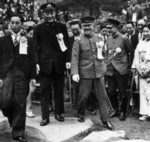Seishiro Itagaki
| Surname | Itagaki |
| Given Name | Seishiro |
| Born | 21 Jan 1885 |
| Died | 23 Dec 1948 |
| Country | Japan |
| Category | Military-Ground |
| Gender | Male |
Contributor: C. Peter Chen
ww2dbaseSeishiro Itagaki was born in the city of Morioka in Iwate, Japan. He graduated from the Japanese Army Academy in 1904 and shortly after participated in the Russo-Japanese War. Between 1924 and 1926, he served as a military attaché at the Japanese embassy in China. Between 1926 and 1927, he was attached to the Army General Staff. In 1927, he was named the commanding officer of the 33rd Infantry Brigade of the 10th Division based in China. Between 1928 and 1929, he served with the 33rd Infantry Regiment of the Kwantung Army in China. In 1931, he was named the Chief of the Intelligence Section of the Kwantung Army. Later in the same year, he helped plan the Mukden Incident that escalated the conflict with China and soon led to the establishment of a Japanese-sponsored puppet kingdom in northeastern China. Between 1932 and 1934, he served as a military advisor to the said puppet kingdom, Manchukuo. He became the vice chief of staff of the Kwantung Army in 1934, and the chief of staff in 1936. Between 1937 and 1938, Itagaki was the commanding officer of the 5th Division in China; in this role, he played a part in the Battle of Beijing and Tianjin and other engagements during the opening chapters of WW2 in Asia. Between 3 Jun 1938 and 30 Aug 1939, he served as the War Minister under Prime Minister Konoe Fumimaro and Hiranuma Kiichiro. As the War Minister, in Dec 1938, as one of the Five Minister Council under the leadership of Prime Minister Fumimaro Konoe, declared that the deportation of Jews in Japan, including occupied territories in China and Korea, was prohibited; this decision was made in accordance to Konoe's Hakko Ichu ("all the world under one roof") policy. Between 1939 and 1941, he served as the chief of staff of the Japanese Army's China Expeditionary Army. In Jul 1941, he was given command of the Chosen Army in Korea; although a promotion, this assignment to a rear area command meant Itagaki was to play only a minor role in the rest of the war. In Apr 1945, he was reassigned to the Seventh Area Army in Singapore and Malaya. In Sep 1945, he surrendered Japanese forces in Southeast Asia to British Admiral Louis Mountbatten in Singapore. He was found guilty of war crimes by the International Military Tribunal, Far East in Tokyo, Japan and was sentenced to death by hanging, which was carried out in Dec 1948 at Sugamo Prison in Tokyo.
ww2dbaseSource: Wikipedia
Last Major Revision: Aug 2011
Seishiro Itagaki Interactive Map
Photographs
 |  |
Seishiro Itagaki Timeline
| 21 Jan 1885 | Seishiro Itagaki was born in Morioka, Iwate, Japan. |
| 23 Mar 1936 | Seishiro Itagaki was named the chief of staff of Kenkichi Ueda (Japanese Kwantung Army in northeastern China). |
| 3 Jun 1938 | Seishiro Itagaki was appointed the War Minister of Japan. |
| 6 Dec 1938 | Seishiro Itagaki, as one of the Five Minister Council under the leadership of Prime Minister Konoe Fumimaro, declared that the deportation of Jews in Japan, including occupied territories in China and Korea, was prohibited. |
| 7 Jul 1941 | General Seishiro Itagaki was named the commanding officer of the Japanese Chosen Army in occupied Korea, relieving Kotaro Nakamura. |
| 18 Aug 1945 | At the headquarters of the Japanese 7th Area Army in Singapore, General Seishiro Itagaki informed his lieutenants and colonial administrators that Japan had surrendered. He ordered the men to maintain public order and to plan for the transition of power when the British colonial administration would arrive. He also ordered the construction of an internment camp in Jurong in western Singapore for Japanese civilians, who would wait there until repatriation. |
| 4 Sep 1945 | Seishiro Itagaki surrendered to Allied troops in Singapore. |
| 12 Sep 1945 | The Japanese forces on Singapore officially surrendered to Louis Mountbattan of Allied South East Asia Command at the City Hall. Field Marshal Hisaichi Terauchi was unable to attend the ceremony due to health reasons, thus Seishiro Itagaki of Japanese 7th Area Army stood in as the alternate representative. |
| 22 Feb 1946 | General Seishiro Itagaki formally surrendered the Japanese Seventh Area Army to Lieutenant General F. W. Messervy at a ceremony in Kuala Lumpur, Selangor, Malaya. |
| 23 Dec 1948 | Seishiro Itagaki was executed by hanging at Sugamo Prison, Tokyo, Japan. |
Did you enjoy this article or find this article helpful? If so, please consider supporting us on Patreon. Even $1 per month will go a long way! Thank you. Share this article with your friends: Stay updated with WW2DB: |
» Mukden Incident
» Lugou Bridge Incident and Second Battle of Hebei
» Battle of Chahar
» Battle of Shanxi
» Battle of Xuzhou
» Japan's Surrender
- » 1,150 biographies
- » 337 events
- » 43,917 timeline entries
- » 1,241 ships
- » 350 aircraft models
- » 207 vehicle models
- » 375 weapon models
- » 123 historical documents
- » 260 facilities
- » 470 book reviews
- » 28,547 photos
- » 432 maps
Winston Churchill